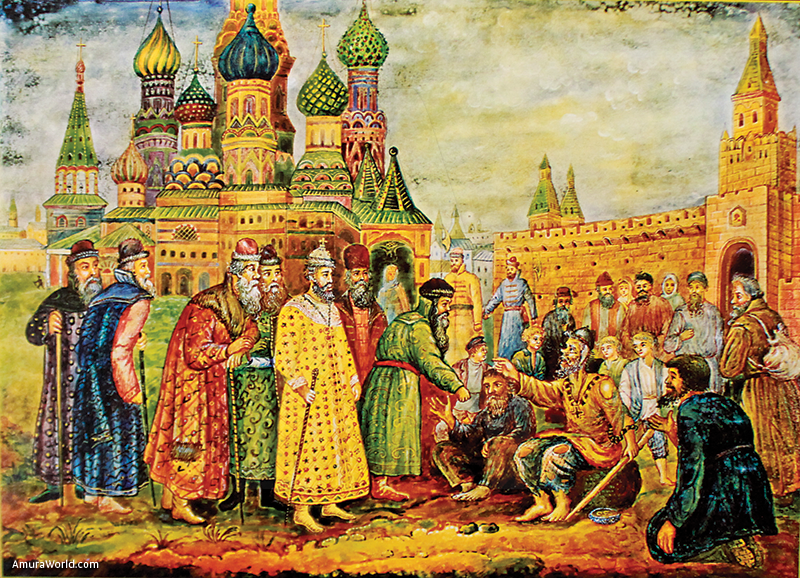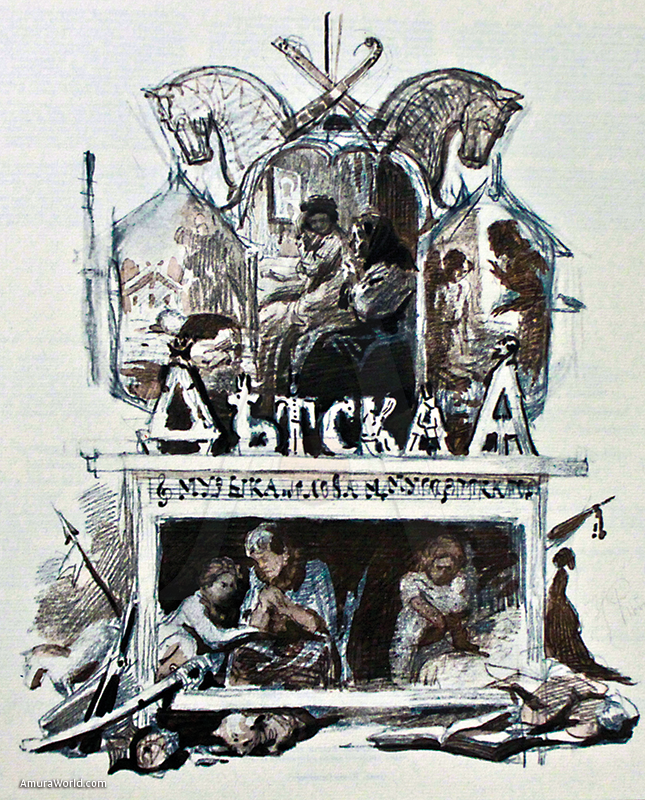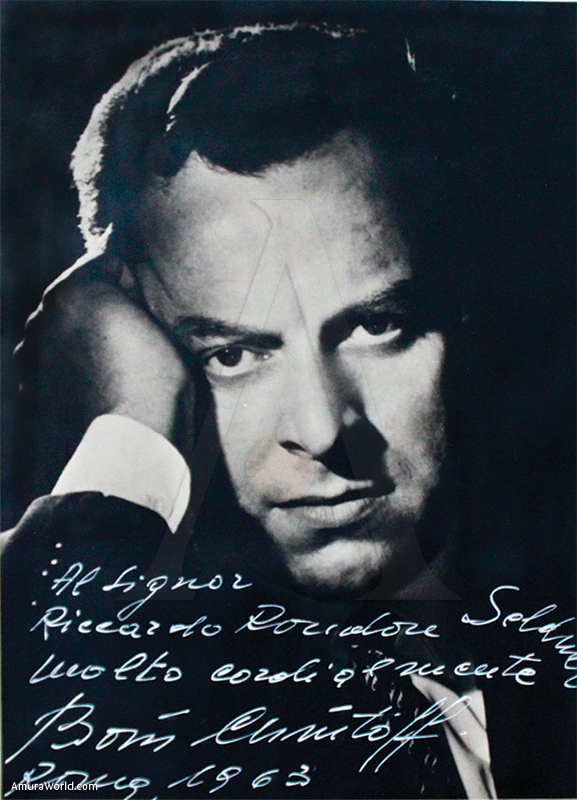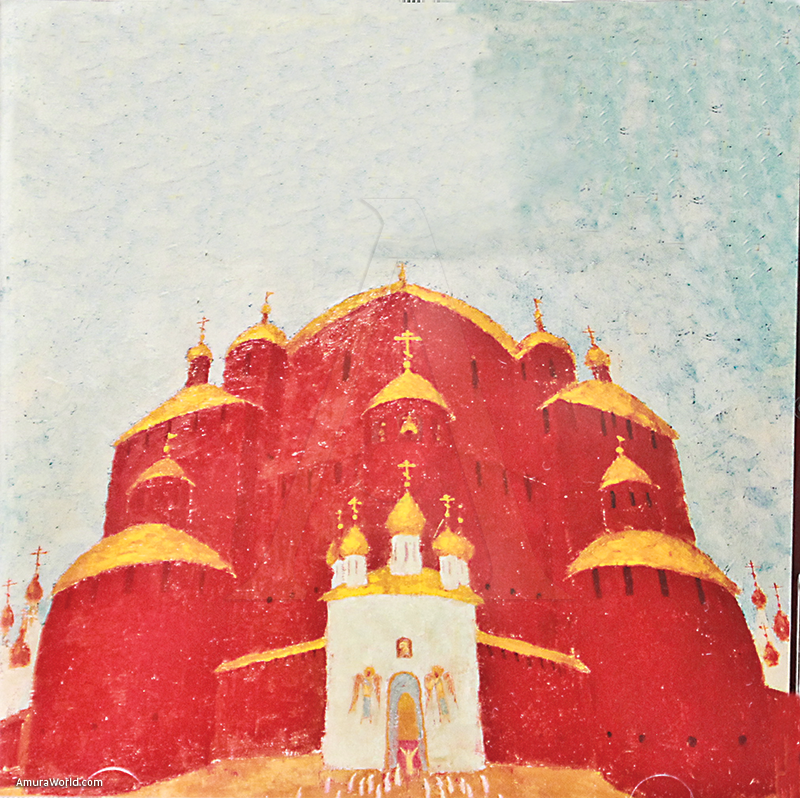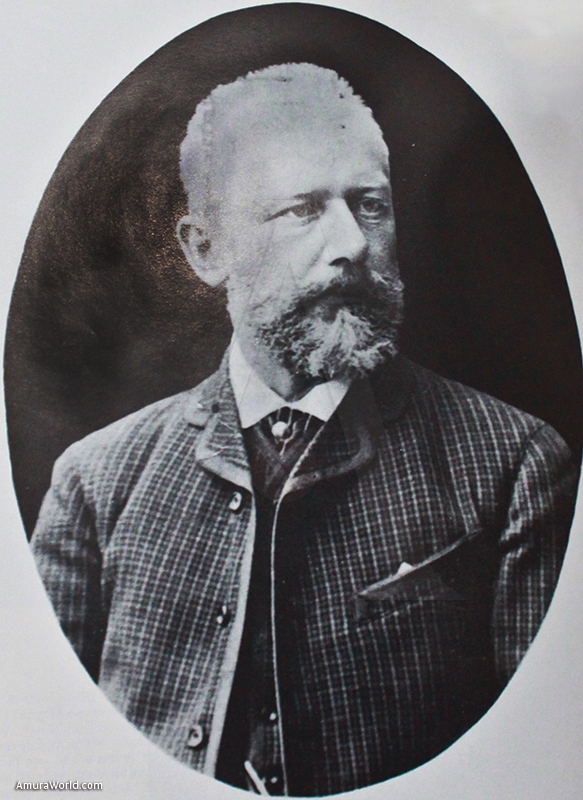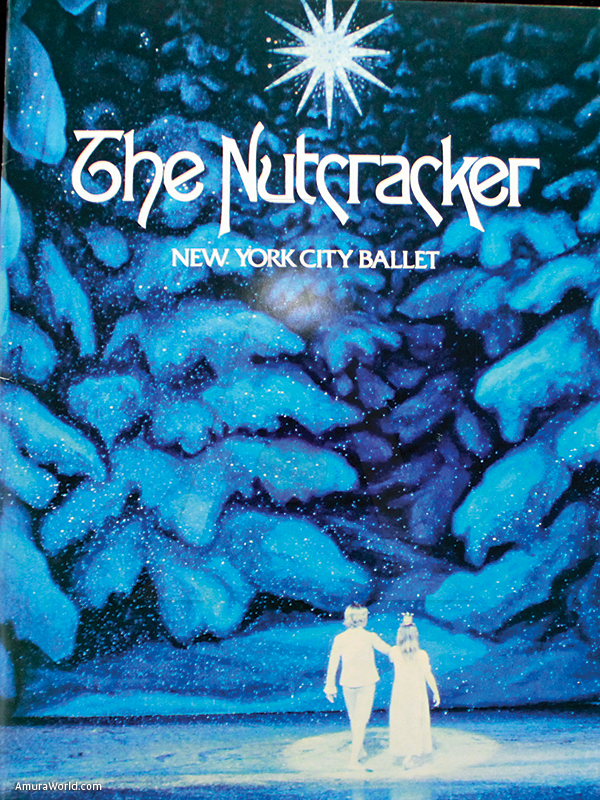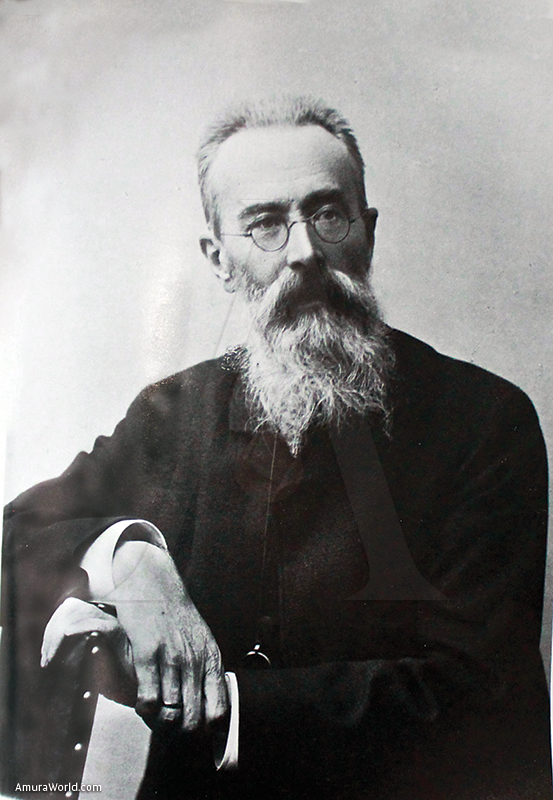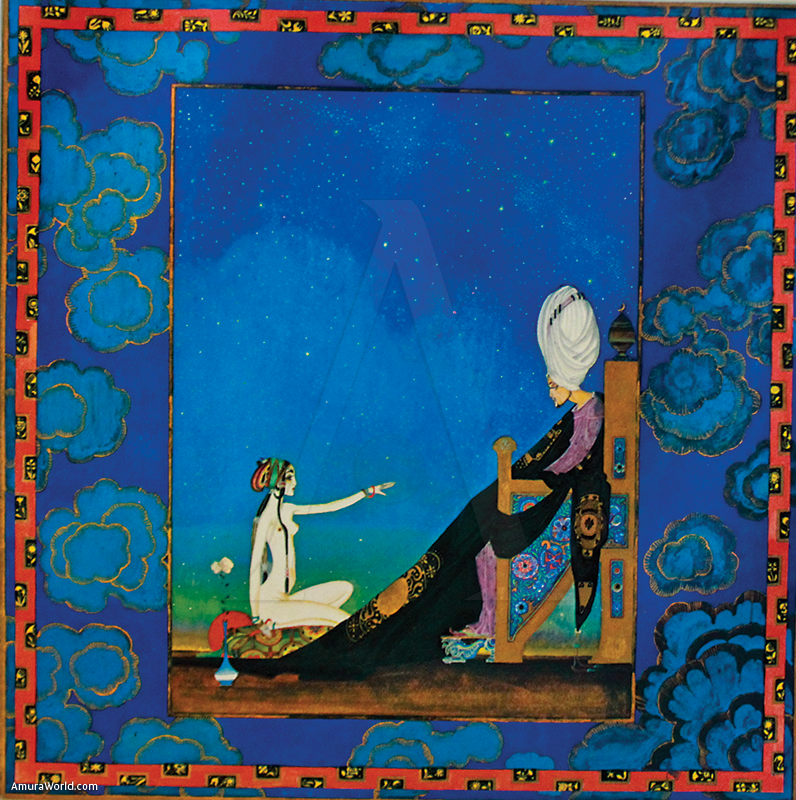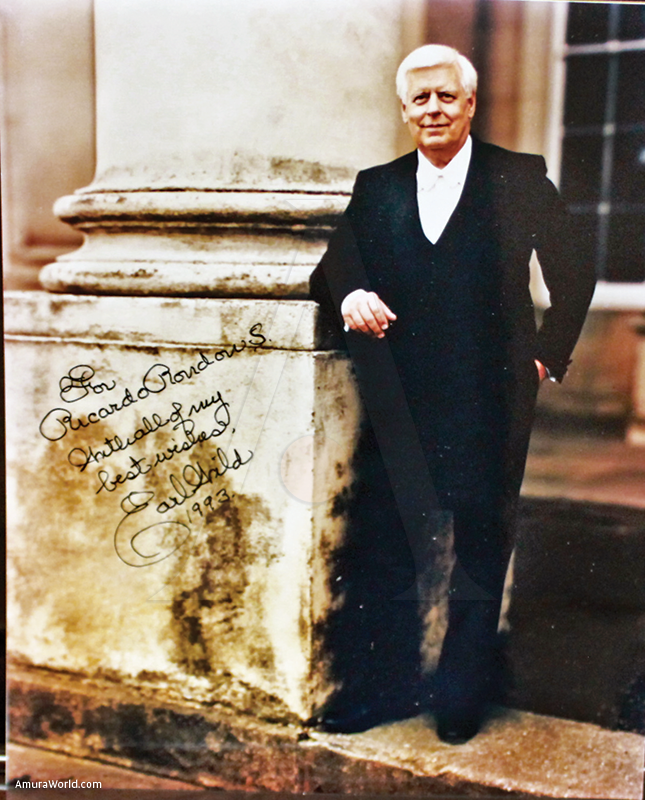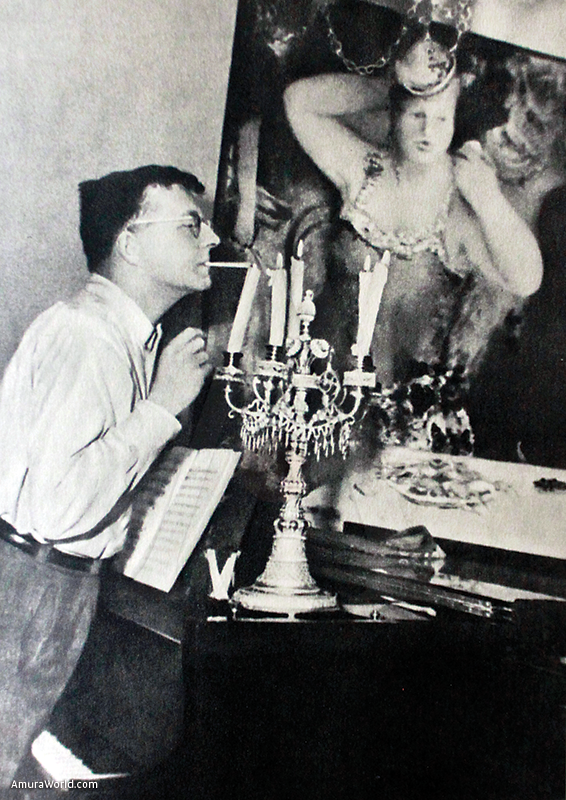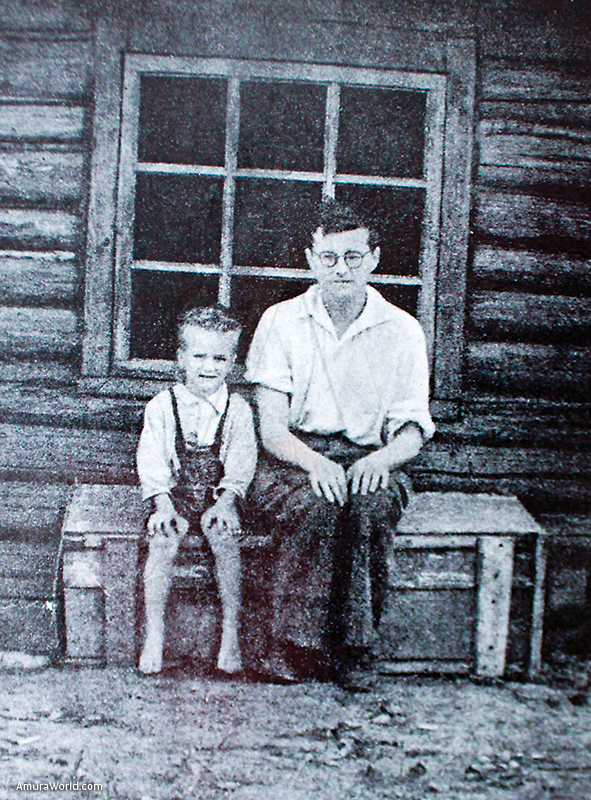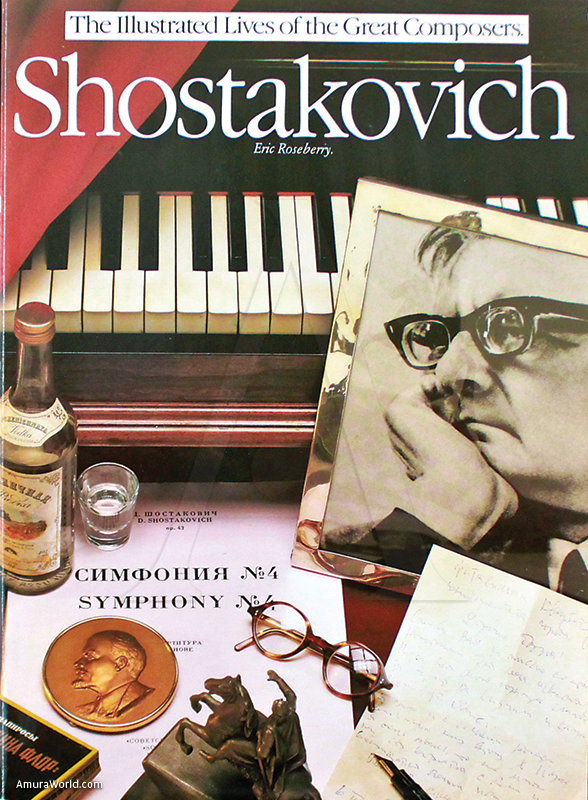Musical Glories
The negative reaction to the music of Richard Wagner was reflected in several ways,including the Impressionism of Debussy and the Expresionism of Arnold Schoenberg. It also was welcomed in the National movement that appeared in Russia amongst the group of musicians called The Mighty Handfull. Inspired by the examples of Glinka, and Dargomizhsky; composers Balakirev,Borodin, Moussorgsky, Cui and Rimsky-Korsakov, did not accept that their music was a reflexión of other countries,specially Germany. In their misión to communicate individuality they arrived to a style that had deep roots in the Russian language and true folklore. They created a type of music that cannot be mistaken for any other country. In next generations the influence of the Mighty Five is felt in the superior Works of Piotr Ilich Tchaikovsky, Serge Rachmaninoff and also Dmitri Shostakovich.
MODESTE MOUSSORGSKY (1835-1881)
If asked who is the greatest Russian composer, without a doubt the answer is Modest Moussorgsky. The psychological penetration in his Works, an extraordinary creative fertility and the eternal presence of the chorus that represents the people are only a few of the reasons that put him above the others. Most of his Works remained unfinished and there are several editions of his opera Boris Godounov. Rimsky-Korsakov’s edition polished many of his ideas but allowed the work to be performed. Nevertheless, today we prefer the original which is more impressive. You cannot polish and file a bark as solid as this.
Moussorgsky was born in a family of land owners and educated at the School for Cadets. After graduation he became an Officer in the Prebroiansky Regiment where alcoholism was rampant.
As a child he studied piano with Dargomizhsky, a pupil of Glinka. As a member of The Five he received a second education, this time musical fromBalakirev with énfasis in technique of composition.. He resigned his army commission in 1857 to devote himself to music, and accepted a Government clerkship at a pittance, which left him time to compose and purchase vodka. He lived a few years with Rimsky-Korsakov, who edited and edited some of his compositions. After Rimsky-Korsakov was married, Moussorgsky lived alone and went rapidly to the bad. He drank too much, took drugs ,had epileptic fits and was deserted by his friends.
When Boris was premiered in 1868 it was a sucess with the audience but Cui gave it a terrible review which was poison for Moussorgsky who called him a souless traitor. Boris was destined to live and the elegant piano pieces of Cui are of no interest to anybody.
He died alone , a charity patient at the St. Nicholas Military Hospital. Not unitil after his death was his true stature revealed.
Boris Godounov:Prologue
Boyar Boris Godounov has ordered the murder of Tsarevitch Dmitri in order to usurp the throne of Russia. Remorse and madness have pursued him until his death. Here, having taken refuge in the convent , he hears the people beg him to accept the throne while they are being flogged. A group of Pilgrims arrive at the convent and their voices are combined in an impressive choral scene.
Slovak Philharmonic Chorus, Bratislava, Rundfunkchor Berlin, Berlin Philhrmonic
Norbert Balatsch, Chorus Directiion
Claudio Abbado, Conductor
Pictures at an Exhibition.
Composed originally fo the piano( 1874) later scored for orchestra by Maurice Ravel, at the request of Serge Koussevitzky who gave the work its first performance at Paris in 1923.
One summer day in the Eighteen-Seventies, Moussorgsky was walking home with his close friend Victor Hartman, a gifted architect , then barely thirty-nine. At a street corner the latter faltered and leaned against a wall. Deliberately careless, the composer asked: “What’s up?” “I can’t breathe”, gasped the stricken man. Moussorgsky, who somehow already knew that his friend’s death warrant had been signed.
A short time later Hartman died and his friends arranged an exhibit of his water colors and drawings to honor his memory. Moussorgsky, of course atended. He felt keenly the loss of his friend, and decided to compose a musical interpretation of some of the pictures. This he did in a single great spirit of creative invention. However, since he strove to achieve true caracterizations of Hartman’s pictures rather than mere salón pieces, pleasant to listen to but otherwise meaningless,he naturally violated prevalent convention. This trespassing in the shrine of “musical beauty” was promtly seized upon by his contempoaries as another illustration of his musical uncouthness-of his lack of formal musical training. In fact, such pieces, as the Gnome, or Samuel Goldenberg and Schmuyle, or even Baba-Yaga’s Hut, were regarded as Works of unparalleled and unforgiveable audacity .
Guide to listening:
Promenade: In this broad Russian melody Moussorgsky portrays himself strolling through the exhibit. The genial tune reappears from time to time, skillfully varied to fit the occasion.
-The Gnome: Hartman’s picture shows a dwarf,hobbling clumsily. There is something malevolent about him -and the music-as he drags himself past us,glaring angrily out of the corner of his eye.
-The Old Castle: A troubadour sings a long drawn out , haunting and melancholy song.
-Tuileries: Nurses and children in a joyous confusión of voices.
-Bydlo: A peasant wagon drawn by oxen . Wheels turn while the driver sings a rich folk tune. This is the soul of Russia at its richest.
Promenade
-Ballet of unhatched chicken:
A whimsical piece, and a great favorite with concert audiences.
-Samuel Goldenberg and Schmuyle. Two typical Warsaw Jews arguing . One is fat, abusive, arrogant and the other thin,nervous and shrill. In this conversation we hear a whiny voice and a deep sound that ends the discussion. It is one of the masterstrokes of psychological writing in music.
-The Market place at Limoges:a grand market in South-Western France. A scene of confusión-of fish,vegetables, wrangling women, flowers and fruit-a typícal market place-then he moves on to….
-Catacombs:
A mysterious and somber place with humid walls and bygone memories.
-Baba-Yaga’s Hut::Picture shows a hut perched on fowls’. legs. Moving in mighty forward spurts, the music describes a witches’s flight through the air on her gruesome errand-a search for human bones. (Baba-Yaga is a witch out of Russian Folklore).
-The Great Gate of Kiev. The picture shows an architectural design of the entrance gate for the city of Kiev. The music is vaguely reminiscent of the Promenade but more solid as if to suggest the grandeur of the massive Stone portals in this final picture at an exbibition.
Berlin Philharmonic Claudio Abbado,Conductor.
PIOTR ILICH TCHAIKOVSKY (1840-1893)
Tchaikovsky was born in Kamsko-Votinsk, Russia in 1840, being the son of a Mining engineer. Showed no startling gift for music as a child and was steered toward a civil Service career. Was graduated from law school to a government clerkship but turned face at twenty-three to devote himself solely to music. Within two years established himself as a ranking musician in his own country and was,along with Borodin,the first Russian composers to win a large following abroad. Devoted himself in later years largely to composition. Died of cholera in 1893 (agee 53) at St. Petersburg,Russia.
Tchaikovsky’s music is highly subjective, occasionally banal,but always intense,even poignant,in its expression of the darker,brooding moods. In its lighter vein it can be charming, elegant, and even sparkling, but it seldem reaches a plane of contagious gaiety or real light-hearted merriment.
Concerto No. 1 for Piano,Op. 23
Premiere: Boston, 1875
Tchaikovsky’s First Piano Concerto was dedicated to Nicholas Rubinstein, an eminent musician who he turned to for an opinión. It was a horrible experience, in the words of the artist: “I played the First movement. Not a single word,not even a comment. If you could only know how intolerably foolish one feels when one sets before a friend a dish of one’s own making and the friend eats it-and says nothing…..At least say so! Find fault if you wish,in a friendly way,but for heaven’s sake speak out- Utter a sympathetic Word even if you can’t offer praise….. I took patience and played the piece through. Silence again. Well, I said as I rose from the piano. Then there came gushing from Rubinstein’s mouth a a veritable torrent of words…..It appeared that my Concerto was worthless,absolutely unplayable……”
Stung to the quick by this explosive rejection, Tchaikovsky promtly erased the original inscription and re-dedicated the Concerto to von Bülow,famous German conductor, who took the composition to America and played it in its initial performance with the Boston Symphony Orchestra. In a short time it bécame one of the all time favorites of music lovers and has been recrded by all the great pianists and never left the basic repertoire of the top orchestras. The heart of the composition beats happily in the dreamy Andante of the Second movement.
-Wild, Royal Philharmonic Orchestra, Fistoulari
The Nutcracker, Op. 71
Premiere: St. Petersburg, 1892
Early in 1891 Tchaikovsky was commisioned to write a ballet for the Imperial Opera in St. Petersburg. Though not too pleased, for he was then in the throes of composing his opera Pique-Dame (The Queen of Spades), set to work and completed most of the first act before leaving Russia to fulfill an engagement that took him to Paris and New York. The ballet is based on a story by E.T.A. Hoffmann.
While in Paris he Heard coming from an open window, beautiful musical sounds such as he had never Heard before. Investigation uncovered an entirely new musical instrument, the celesta, recently been invented by a Frenchman. A small girl Maria receives a Nutcracker as a Christmas gift. During the night stealing downstairs to see her new toy she is overtaken by a troupe of mice . The reupon all the toys come to life and the Nutcracker commands and army of toy soldiers in a battle against the mice who follow the ugly King who almost kill the Nutcracker. He is saved by Maria and becomes a handsome Prince who takes her to the Kingdom of Sweets.
-Royal Concertgebouw Orchestra of Amsterdam, Dorati
NICOLAI RIMSKY-KORSAKOV (1844-1908)
Born 1844 at Thivin,Russia,of noble parents with peasant blood from both grandmothers,one of them a serf. Loved sailing from childhood and studied at the Naval Academy. Has an extensive training cruise. Upon returning renewed friendship with Balakiev who motivated his interest in music and invited him to be part of the National Academy. Despite not having a formal education he was named Profesor in Composition at the Conservatory of St. Petersburg. Rimsky took full advantage of the post in order to fill in his weaknesses and he is considered “father of the orchestratuion of the Twentieth Century”. He died when he was 64 years in St. Petersburg.
His music is highly descriptive based on Slavonic folk legends and full of colorful orchestrations. Brilliantly sensual he describes the Orient with unforgettible sensuous melodies.
Scheherazade, Symphonic Suite (After The Thousand and One Nights) Op. 35
Premiere: St. Petersburg, Winter 1888-89
The story of Scheherazade, drawn from the Arabian Nights, is concerned with the powerful Sultan Schariar who,convinced of all women’s unfaithfulness, decides to put his wives to death. One of theses, Scheherazade,saves herself by spinning colorful yarns which,stretching over one thousand and one nights in the telling, so intriogue the Sultan that he changes his mind and spares her life. The voice of Scheherazade is assigned to the first violin of the orchestra while the narrative captures our interest and imagination.
-Krebbers, Royal Concertgebvouw Orchestra of Amsterdam, Kondrashin.
Russian Easter Overture, Op. 36
Premiere: 1888
Rimsky-Korsakov based his Overture on the melodic part of the Obikhod, a collection of canticles of the Russian Orthodox Church. Its describes the Pagan-Christian ritual of Old Russia known as “Luminous Festive Day”.
The central part is a formidable description of the Prophet Isaiah concerning the resurrection of Christ. The music increases its pulse and when played as it should be, captivates the audience. The orchestration is another example of the complete genius Rimsky was in the handling of the instrumentalists.
-Philharmonia Orchestra,Svetlanov
SERGEI RACHMANINOFF
(1873-1943)
Born in 1873 on an Estate near Novgorod,Russia. At nine when his parents seperated was taken by his mother to St. Petersburg and enrolled in the College of Music. Later, bécame a student at the Moscow Conservatory, a protegé and spiritual disciple of Tchaikovsky. For a time he was undecided whether to take up piano playing or composition as his major activity,finally settled on the former,especially after he left Russia in 1918. Yet through the years,though producing little, Rachmaninoff grew steadily in stature as a composer. . His music is the most nostalgic of its times and continues to describe a Russia of the past. His themes are able to handle sadness,,pessimism and a positive expression.
Concerto No. 2 for Piano, Op. 18
Premiere: Moscow,1901
After the failure of the First Symphony, Rachmaninoff fell into a severe depression. The reviews were so vitriolic that he seriously considered to stop composing. For two years he did practically nothing. He saw no one, nor did he write music. He would spend the hours buried in loneliness with his dog at his side. Then,unable to rid himself of his strange apathy, he had recourse to a physician, Dr. Dahl, whose method of suggestion andd auto-suggestion had been called miraculous by former patients. After three months, Rachmaninoff was cured and started work on his Second Piano Concerto. Gratitude led him to dedicate this masterpiece to Dr. Dahl. It is a public favorite all over the world.
-Concerti for Piano (4), Rhapsody on a Theme of Paganini
-Wild, Royal Philharmonic Orchestra, Fistoulari
DMITRI SHOSTAKOVICH (1906-1975)
DMITRI SHOSTAKOVICH (1906-1975)
Studied with his mother, a profesional pianist and later Shteynberg at the Petrograd Conservatory. Wrote his First Symphony when he was 19 years old as a graduation excersize. The Jury said:”Sufficiently modern to be interesting, and sufficiently academic to be agreeable”. Several minor Works followed, all covering Soviet propaganda and he decided to try his luck with an opera, The Nose which was criticized as a piece of bourgeois decadence. Nothing daunted, he wrote a second opera, Lady Macbeth of Mzensk, a remarkable work which was well received. At a famous performance in Leningrad, Josef Stalin ,tyrant,Dictator and “Music expert” walked out of the performance and the oficial newspaper Pravda took part on the attacks that followed. Shostakovich taught at the Lenin Conservatory, wrote piano pieces, chamber music and film music and bided his time. Vindication came with the Fifth Symphony which has been played ever since all over the world.
It contains all the power of the composer and personal anxieties. He said:” it is the victory of light sover darkness, of humanity over barbarism”. In Mexico Shostakovitch is played regularly and attracts young music lovers that respond to his musical ideas and expressive forcé. He came to México in 1957 as part of a Committee of Musicians and Artists. His music is the voice of the New Russia that resounds throughout the world.
Concerto No. 2 for Piano Op,.102
-Ogdon, Royal Philharmonic Orchestra, Foster
The beauty of the second movement has made it popular due to a perfect combination that embraces it between two vigorous movements.
-Symphony No. 8
Written in 1943 it narrates the horrors of war, disilusion and the persuit of hope. Without a doubt, a masterpiece.
-Royal Liverpool Philharmonic,Petrenko.
Text: Ricardo Rondón ± Photo: Ricardo Rondón/ Axel Carranza

